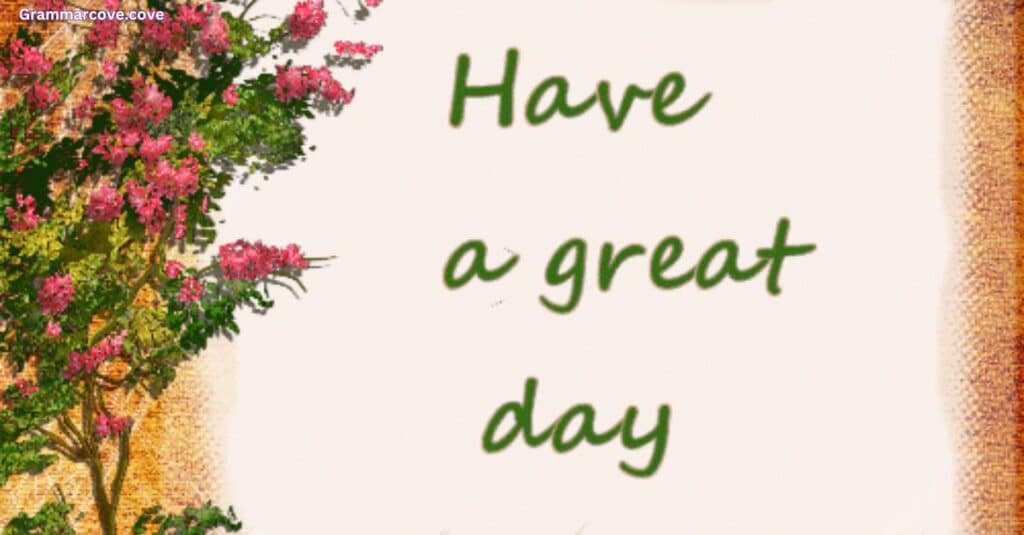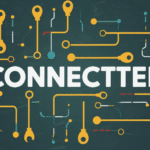
We’ve all been there—wrapping up a conversation or an email and wanting to wish someone well. While “have a good day” is the go-to phrase, it can get a bit stale. If you’re looking for other ways to say “have a good day,” you’re in luck!
Whether you’re aiming to enhance your vocabulary or simply want to add some flair to your farewells, there are plenty of alternatives that can make your goodbyes more memorable and heartfelt.
We’ll dive into the nuances of sentence structure and writing style that make each alternative shine. So, let’s jump in and revolutionize the way we say goodbye with other ways to say “have a good day!”
1. “I hope your day is as wonderful as you are!”
This personalized twist on the classic “have a good day” adds a touch of warmth and sincerity. It’s perfect for close friends, family members, or colleagues you have a good rapport with. The sentence structure here compliments the recipient while wishing them well, making it a double whammy of positivity.
Example scenario:
Ending a catch-up call with a friend:
“It’s been great catching up, Sarah! I hope your day is as wonderful as you are! Talk to you soon!”
2. “May your day be filled with success and joy!”
This phrase is like a mini-blessing, perfect for adding a dash of positivity to someone’s day. It’s particularly suitable for professional settings or when you want to motivate someone facing a challenge. The use of “may” at the beginning gives it a slightly formal tone, making it appropriate for various situations.
Example scenario:
Concluding a work email to a team member:
Dear Alex,
I've reviewed the project proposal, and it looks great. I've attached my feedback for your consideration.
May your day be filled with success and joy!
Best regards,
Jamie3. “Wishing you a day as bright as your smile!”
Here’s a cheerful alternative that’s bound to make the recipient grin. It’s perfect for lightening the mood and works well with friends, family, or colleagues you have a friendly relationship with. This phrase cleverly uses a simile, comparing the day to the person’s smile, which adds a personal touch.
Example scenario:
Sending a good morning text to a partner:
“Good morning, sunshine! Wishing you a day as bright as your smile! Can’t wait to see you later. ❤️”
4. “I hope your day treats you well!”
This phrase puts a unique spin on the traditional “have a good day” by personifying the day itself. It’s a versatile option that works in both casual and professional settings. The writing style here is conversational yet polite, making it suitable for a wide range of situations.
Example scenario:
Ending a customer service call:
“Thank you for choosing our services, Mr. Thompson. I hope your day treats you well! Don’t hesitate to reach out if you need any further assistance.”
5. “Here’s to a fantastic day ahead!”
This upbeat phrase feels like a mini-toast to the day ahead. It’s energetic and optimistic, making it perfect for morning interactions or whenever you want to instill a sense of excitement about the upcoming day. The use of “Here’s to” at the beginning gives it a celebratory feel, adding a touch of warmth to your farewell. If you’re looking for other ways to say “have a good day,” this is a fantastic option!
Example scenario:
Starting a team meeting:
“Good morning, everyone! Before we dive into today’s agenda, I just want to say: Here’s to a fantastic day ahead! Let’s make it count!”
6. “Sending positive vibes your way for a great day!”
This modern, slightly new-age phrase is perfect for casual settings and younger crowds. It’s a fun way to express well-wishes without sounding too formal. The phrase “sending positive vibes” has become increasingly popular in recent years, reflecting changes in language usage.
Example scenario:
Responding to a friend’s Instagram story:
“Love the new haircut, Jess! Sending positive vibes your way for a great day! 🌟”
7. “I hope your day is nothing short of amazing!”
This enthusiastic phrase sets high expectations for the day ahead. It’s perfect when you want to really emphasize your well-wishes, perhaps for someone facing a big day or needing an extra boost of confidence. The sentence structure here, using “nothing short of,” adds emphasis to the wish.
Example scenario:
Wishing a colleague good luck before a big presentation:
“You’ve got this, Taylor! I hope your day is nothing short of amazing! Can’t wait to hear how the presentation goes.”
8. “May today bring you countless reasons to smile!”
This lovely phrase focuses on the positive experiences the day might bring. It’s a great option when you want to encourage someone to look for the bright side in their day. The use of “countless” adds a touch of hyperbole, emphasizing the abundance of potential joy.
Example scenario:
Ending a heartfelt email to a friend going through a tough time:
Dear Rachel,
I know things have been difficult lately, but remember that you're stronger than you think. May today bring you countless reasons to smile! I'm always here if you need to talk.
Hugs,
Emma9. “Wishing you a day full of pleasant surprises!”
This phrase adds an element of excitement and anticipation to your well-wishes. It’s perfect for birthdays, special occasions, or when you know someone has been feeling a bit down. The mention of “pleasant surprises” encourages the recipient to approach their day with optimism and openness. If you’re exploring other ways to say “have a good day,” this phrase is a wonderful choice!
Example scenario:
Sending a birthday message:
“Happy Birthday, Mark! Wishing you a day full of pleasant surprises! Can’t wait to celebrate with you this weekend. 🎉”
10. “Here’s hoping your day is as awesome as you make mine!”
This heartfelt phrase is perfect for close relationships – be it romantic partners, best friends, or family members. It expresses gratitude for the positive impact the person has on your life while wishing them well. The sentence structure here creates a nice balance between compliment and well-wish.
Example scenario:
Saying goodbye to a spouse before work:
“I’m heading out now, honey. Here’s hoping your day is as awesome as you make mine! See you tonight for dinner.”
11. “May your day be filled with laughter and good fortune!”
This phrase combines wishes for both happiness (laughter) and success (good fortune), making it a comprehensive well-wish. It’s suitable for various situations and relationships, from casual to more formal. The use of “may” at the beginning gives it a slightly formal, almost blessing-like quality.
Example scenario:
Concluding a business networking event:
“It was a pleasure meeting you, Ms. Chen. May your day be filled with laughter and good fortune! I look forward to our future collaboration.”
Mastering the Art of Well-Wishes
Now that we’ve explored these alternatives, let’s dive deeper into why they work and how you can create your own unique well-wishes. Understanding the parts of speech and grammar rules at play can help you craft personalized, impactful phrases.
The Power of Positive Language
Each of these alternatives shares a common thread: they use positive, uplifting language. Words like “wonderful,” “success,” “joy,” “bright,” and “amazing” set an optimistic tone. When crafting your own well-wishes, consider incorporating similarly positive adjectives.
Personalization Is Key
Many of these phrases work well because they’re personalized. They reference the recipient’s qualities (“as wonderful as you are,” “as bright as your smile”) or acknowledge the impact the person has on others (“as awesome as you make mine”). This personal touch makes the well-wish feel more sincere and meaningful.
Varying Sentence Structures
Notice how these phrases use different sentence structures to keep things interesting. Some start with “I hope,” others with “May,” and still others with “Wishing you.” This variety prevents the phrases from feeling repetitive or formulaic.
The Role of Imagery and Metaphor
Several of these alternatives use imagery or metaphor to make the well-wish more vivid and memorable. Phrases like “as bright as your smile” or “filled with laughter” create a mental picture that enhances the impact of the wish.
Adapting to Context
Remember, the best alternative to “have a good day” depends on the context. Consider the relationship between you and the recipient, the setting (professional vs. personal), and any specific circumstances (like a big event or challenge the person is facing).
Enhancing Your Communication Skills

Mastering these alternatives is just one aspect of effective communication. To truly excel in your interactions, consider the following tips:
- Pay attention to tone: The tone of your message should match the relationship and situation. A cheerful “Have an awesome day!” might be perfect for a friend but too casual for a formal business email.
- Practice active listening: Before wishing someone a good day, make sure you’ve truly heard and understood their concerns or thoughts. This will help you choose the most appropriate and meaningful phrase.
- Be genuine: Whatever phrase you choose, make sure it comes from a place of sincerity. People can often sense when well-wishes are merely perfunctory.
- Consider cultural differences: If you’re communicating with people from different cultural backgrounds, be aware that some phrases might not translate well or could be misinterpreted.
- Use appropriate body language: If you’re saying these phrases in person, make sure your body language matches your words. A warm smile and eye contact can enhance the impact of your well-wishes.
Improving Your Writing Skills
While mastering these phrases can certainly enhance your verbal communication, they can also significantly improve your writing style. Here are some writing tips to keep in mind:
- Vary your closings: Just as we’ve explored alternatives to “have a good day,” consider varying your email closings or letter endings. This keeps your writing fresh and engaging.
- Mind your punctuation: Proper punctuation rules are crucial in written communication. For example, remember to use a comma before the person’s name in a direct address: “Have a great day, John!”
- Proofread carefully: Always take a moment to review your writing before sending it. Proofreading techniques like reading your text aloud can help you catch errors and awkward phrasing.
- Consider the medium: The way you express well-wishes might differ depending on whether you’re writing an email, a text message, or a formal letter. Adapt your language accordingly.
- Use grammar checker tools: While not infallible, grammar checker tools can be helpful in catching common mistakes and improving your overall writing quality.
Expanding Your Linguistic Horizons
Exploring alternatives to common phrases like “have a good day” is just the tip of the iceberg when it comes to enhancing your language skills. Here are some ways to continue improving:
- Build your vocabulary: Regularly learning new words and their synonyms and antonyms can help you express yourself more precisely and creatively.
- Take online writing courses: There are numerous online writing courses available that can help you improve various aspects of your writing, from basic grammar exercises to advanced creative writing techniques.
- Practice different writing styles: Try your hand at different types of writing, from academic writing skills to business writing etiquette. Each style has its own rules and conventions, and mastering them can make you a more versatile communicator.
- Read widely: Exposure to different authors and styles can greatly enhance your own writing and speaking abilities.
- Seek feedback: Don’t hesitate to ask for input on your writing. Editing and revising based on constructive criticism is a crucial part of improving your skills.
Conclusion
Mastering the art of well-wishes goes beyond simply learning new phrases. It’s about understanding the nuances of language, adapting to different contexts, and genuinely connecting with others. By expanding your repertoire beyond “have a good day,” you’re not just varying your farewells – you’re enhancing your overall language proficiency and communication skills.
Remember, the goal isn’t to completely abandon “have a good day.” It’s a classic for a reason! Instead, these alternatives give you options to make your communication more varied, personal, and impactful. They allow you to tailor your well-wishes to specific situations and relationships, adding depth and sincerity to your interactions.
As you practice these phrases and perhaps create your own, you’ll likely find that your overall communication becomes more nuanced and effective. You might even inspire others to move beyond standard phrases, creating a ripple effect of more thoughtful, engaging interactions.
So, the next time you’re about to end a conversation or sign off an email, pause for a moment. Consider the person you’re addressing, the context of your interaction, and choose a phrase that truly expresses your sentiments. Who knows? Your carefully chosen words might just be the highlight of someone’s day.
And with that, I’ll wrap up this exploration of alternatives to “have a good day.” I hope this article has given you food for thought and some new tools for your communication toolkit. May your future interactions be filled with warmth, sincerity, and just the right words to make others smile!

Steel Morgan is an experienced blogger passionate about language and writing. On Grammarcove. he shares his expertise in grammar, punctuation, and effective communication, making complex rules simple and accessible for readers. With a knack for clear explanations and engaging content, Steel aims to help others master the art of language.







